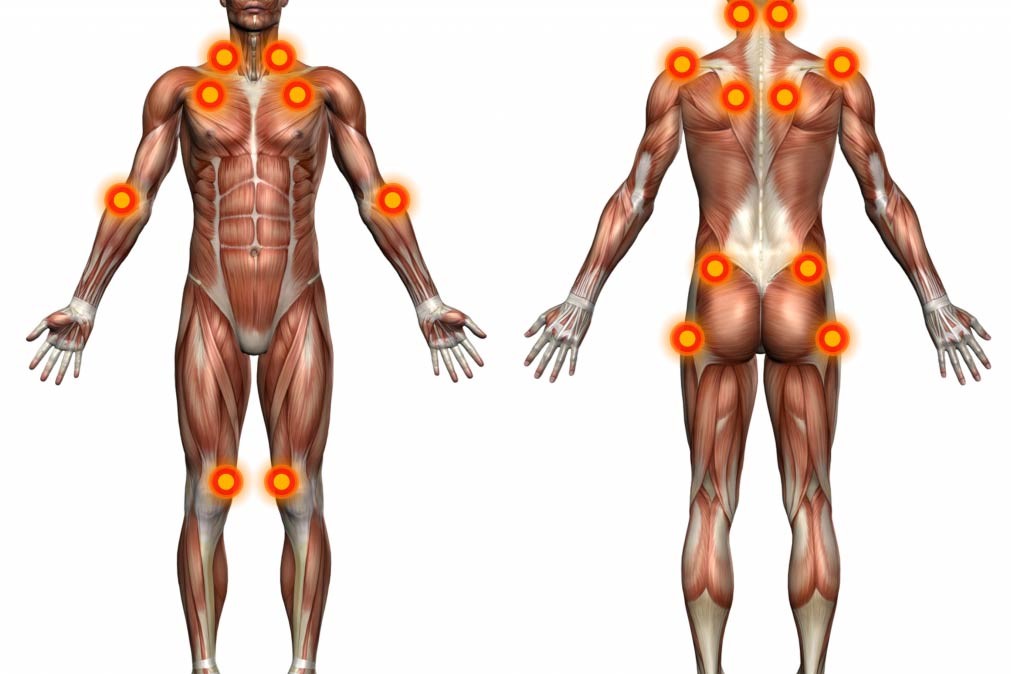
Fibromyalgia, myofascial syndrome, tender points, trigger points: what confusion!
There is some confusion at the diagnostic-therapeutic level between musculo-skeletal pathologies, myofascial syndrome and fibromyalgia, in particular between Tender points and Trigger points, to which is added the complication due to the fact that these forms of pain can coexist in the same patient
Diagnosis of fibromyalgia: tender and trigger points
It is generally accepted that the diagnosis of fibromyalgia is residual.
If a patient has widespread, sometimes variable pain, and nothing physical can be demonstrated, or tests for inflammatory status and rheumatic diseases are negative, then he or she is likely to have fibromyalgia.
In reality, fibromyalgia is a well-coded disease characterised by the presence of numerous bilateral ‘tender points’ and the diagnosis is made by counting the detectable tender points: if they are greater than 11 then the diagnosis of fibromyalgia is very likely.
The map of tender points, where statistically the 18 points that identify fibromyalgia are located, can be easily found on the Internet.
Fibromyalgia: are tender points and trigger points the same thing?
But what are tender points and are they equivalent to trigger points? The answer is no, but it is worth looking into.
Tender points
These are pressure sore points located in well-defined parts of the body.
And pain is only evoked at the location of the tender point and never at a distance.
If one has pressure sore points with circumscribed pain and these are numerous and spread bilaterally then we are in the presence of fibromyalgia.
If, on the other hand, the points are spontaneously painful and project the pain to distant areas, this is probably myofascial pain.
Another difference is the emotional and cognitive manifestations that are present in abundance in fibromyalgia (depressed mood, chronic anxiety, asthenia, poor concentration, etc.) and almost never in myofascial syndrome.
Trigger points
Trigger points, on the other hand, are extremely painful areas located in one or more muscles and are situated in the myofascia, a small layer of connective tissue that surrounds the muscle allowing it to move, without excessive friction, within the fascia that acts as a container.
To the touch it feels like a benderella or painful nodules embedded in the muscle itself. The muscle loses strength and, if not treated by stretching, tends to enlarge the painful area because, in the area surrounding the nodule, an alteration of the venous-arterial microcirculation and of the vessels with the appearance of additional trigger points is determined.
It is obvious that if tender points are confused with trigger points, the diagnosis will be wrong and the therapy unsuccessful.
Read Also
Emergency Live Even More…Live: Download The New Free App Of Your Newspaper For IOS And Android
Fibromyalgia: The Importance Of A Diagnosis
Fibromyalgia: When The Body Feels The Pain Of The Mind
Rheumatoid Arthritis Treated With Implanted Cells That Release Drug
Oxygen Ozone Therapy In The Treatment Of Fibromyalgia
Everything You Need To Know About Fibromyalgia
Long Covid: What It Is And How To Treat It
Long Covid, Washington University Study Highlights Consequences For Covid-19 Survivors
Long Covid And Insomnia: ‘Sleep Disturbances And Fatigue After Infection’
How Can Fibromyalgia Be Distinguished From Chronic Fatigue?
Fibromyalgia: Symptoms, Causes, Treatment And Tender Points
Fibromyalgia: Where Are The Tender Points That Cause Pain On Palpation?
Depression: Symptoms, Causes And Treatment
Depression, Symptoms And Treatment
Major Depressive Disorder: Clinical Features
Emotional Abuse, Gaslighting: What It Is And How To Stop It
What Is Postpartum Depression?
How To Recognise Depression? The Three A Rule: Asthenia, Apathy And Anhedonia
Postpartum Depression: How To Recognise The First Symptoms And Overcome It
Postpartum Psychosis: Knowing It To Know How To Deal With It


